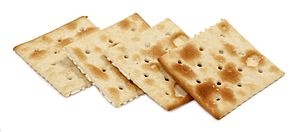Saltine cracker facts for kids
 |
|
| Alternative names | Soda cracker |
|---|---|
| Type | Cracker |
| Place of origin | United States |
| Created by | Frank L. Sommer |
| Main ingredients | Flour, yeast, and baking soda |
| 42 (depending on brand) kcal | |
A saltine or soda cracker is a thin, crispy cracker. It is usually square and made from white flour, sometimes yeast, and baking soda. Most saltines have a light sprinkle of coarse salt on top. They have tiny holes all over their surface, which helps them get their unique dry and crisp texture.
You might know saltines by different brand names. In the U.S., popular brands include Nabisco's Premium, Sunshine's Krispy, and Keebler's Zesta. In Canada, Christie's Premium Plus is well-known. Some saltines are also made without salt on top, or as whole grain versions.
Contents
What Are Saltine Crackers?
Saltine crackers are a type of flat, dry biscuit. They are known for their salty taste and crunchy texture. The small holes you see on them are called perforations. These holes help the crackers bake evenly and stay flat. Without them, the crackers might puff up like balloons!
The Story of Saltines
How Saltines Were Invented
The idea of soda crackers was first mentioned in a book in 1838. But the saltine cracker as we know it came later. In 1876, a company called F. L. Sommer & Company in St. Joseph, Missouri started using baking soda to make their thin crackers rise.
They first called it the Premium Soda Cracker. Later, it became known as "Saltines" because of the salt used in baking. This new cracker quickly became very popular. Sommer's business grew four times bigger in just four years!
Saltines Join Big Companies
Sommer's company later joined with other companies to form the American Biscuit Company in 1890. After more mergers, it became part of the National Biscuit Company (Nabisco) in 1898.
Saltines Around the World
In the early 1900s, U.S. companies started selling soda crackers in Puerto Rico. They called them "Export Soda." This name became very common there. Even local companies like Rovira Biscuit Corp. used the name.
In the United States, the name "saltine" became so popular that it was used for any similar cracker. This meant Nabisco could no longer claim it as their special brand name. The word "saltine" even appeared in the 1907 Merriam Webster Dictionary. However, in Australia, a company called Arnott's Biscuits Holdings still owns the trademark for "Saltine."
Saltines were also made in the United Kingdom by Huntley & Palmers and in Australia and New Zealand by Arnott's under the brand name Arnott's Salada.
How People Use Saltines
Eating Saltines
Saltines are often eaten with soups, chilis, and stews. Many people like to crumble them into their food or eat them alongside salads.
You usually buy saltines in boxes. Inside, there are two to four stacks of crackers, each wrapped in plastic or waxed paper. In restaurants, you might get small packets with two crackers, often with soup or salad.
Saltine Cracker Meal
Crushed saltine crackers can be made into a coarse flour called cracker meal. This meal can be used in many ways:
- As a topping for different dishes.
- To coat poultry, fish, or red meats before frying or baking.
- To make dishes like meatloaf, soups, stews, and sauces thicker.
Saltines for Health
Some people use saltines as a simple home remedy. They eat them to help with nausea (feeling sick to your stomach), diarrhea, or an upset stomach. This is because saltines are plain and easy to digest.
Saltine crackers have also been part of military field rations, like the Meal, Ready-to-Eat (MRE), for soldiers in the United States.
How Saltines Are Made
The Baking Process
Saltines are sometimes compared to hardtack, which is a very simple cracker made from flour, water, and salt. However, saltines are different because they include yeast.
The dough for soda crackers is allowed to rise for a long time, usually 20 to 30 hours. After this first rise, an alkaline substance (like baking soda) is added. This helps to balance the sour taste that the yeast creates. The dough then rests for a few more hours. This resting time helps the dough become stretchy and easy to work with. Finally, the dough is rolled into thin layers and baked.
Why Saltines Have Holes
The flat saltine crackers have many small holes on their surfaces. These holes are very important during baking. When the crackers bake, the outside layer gets hard first. This can trap gases that form inside the dough. The holes connect the top and bottom surfaces of the cracker. This allows the gases to escape and stops the cracker from puffing up like a pillow.
See also
 In Spanish: Galleta de soda para niños
In Spanish: Galleta de soda para niños

